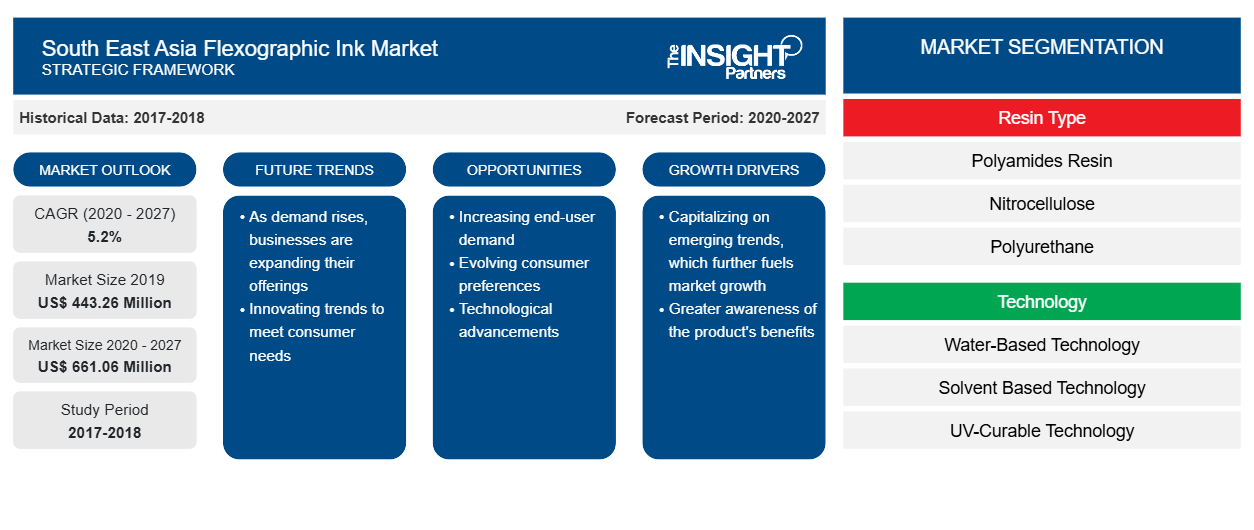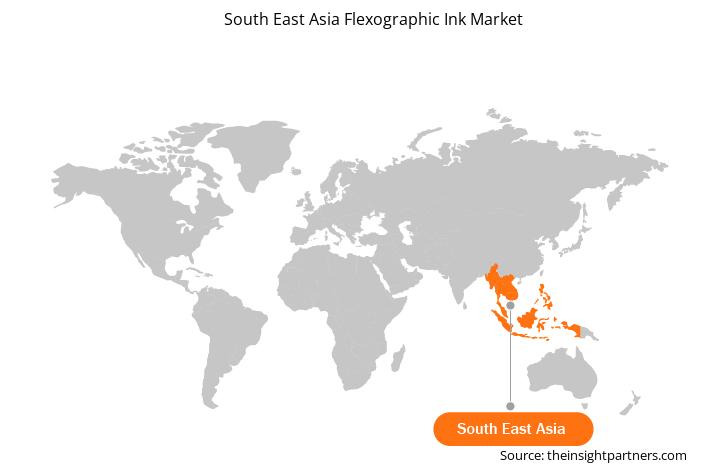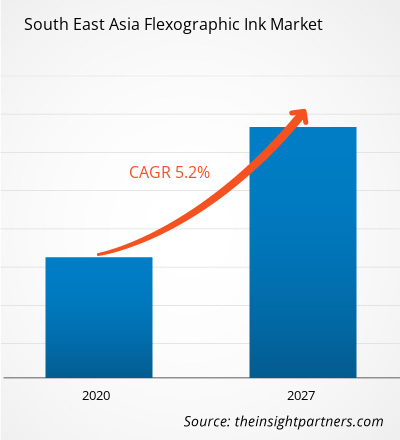The South East Asia flexographic ink market was valued at US$ 443.26 million in 2019 and it is projected to reach US$ 661.06 million by 2027; it is expected to grow at a CAGR of 5.2% from 2020 to 2027.
Flexographic ink, also known as flexo printing ink, is used in the printing of packaging materials such as cardboard boxes, packaged food, paper bags, plastic bags, and newspapers. There is an upsurge in demand for flexographic inks from the packaging industry due to the growing focus of manufacturers on the development of attractive packaging methods and materials for their products. UV curable ink is gaining high acceptance over other inks such as water-based ink and solvent-based ink due to its advantages such as high production output, superior bonding, low volatile organic compound (VOC) content, lowered drying time, reduced rejection rates, and better solvent resistance properties. The demand for UV-curable inks has also increased on the back of continuous changes in environmental regulations, and growing awareness and rising concern toward improving the safety of packaged foods. Technological advancements in the field have reduced the risk of fading, delamination, and bubble formations, which is anticipated to further drive the demand for flexographic inks.The COVID-19 outbreak first began in Wuhan (China) in December 2019, and since then, it has spread at a fast pace worldwide. As of September 2020, Malaysia, Singapore, Thailand, and Vietnam are among the highly affected South East Asian countries in terms of confirmed cases and reported deaths. The COVID-19 pandemic has been affecting economies and industries in various countries due to lockdowns, travel bans, and business shutdowns. Chemicals and materials is among the major industries facing serious disruptions.
South East Asia Flexographic Ink Market
Market Insights
Growing Demand for Flexographic Ink from Packaging Industry Fuels Market Growth
The demand for flexographic inks in the South East Asian market is majorly driven by the rapid growth in industrialization and packaging industry in countries such as Malaysia, Singapore, Thailand, and Vietnam. Increasing commercialization of flexible packaging due to its widespread applications is projected propels the demand for flexographic inks. Packaging is of utmost importance in industries such as cosmetics, pharmaceuticals, personal care products, and food & beverages. Attractive and colorful packaging is a key marketing tool that impacts the overall purchasing decision of customers. It increases the aesthetic appearance, offers product differentiation, and enhances company’s brand image. Additionally, continuous growth in the aforementioned industries, mainly due to improved consumer spending, is projected to augment the demand for flexible packaging, and thus flexographic printing inks, in the South East Asian market.
The rising interest of packaging companies in the development of attractive packaging methods and materials is also contributing to the rise in demand for flexographic inks. Innovative packaging helps companies in improving product presentation and differentiation, sustaining competitive rivalry, and enhancing product shelf-life. The demand for flexographic ink increases with the growth of the packaging industry as it is a key consumer of this product. Surging demand for printing inks in packaging applications such as tags and labels, flexible packaging, and folding cartons drives the South East Asian flexographic ink market.
Resin Type Insights
Based on resin type, the flexographic ink market is segmented into flexographic polyamides resin, nitrocellulose, polyurethane, acrylic resins, and others. In 2019, the acrylic resins segment led the market with the largest market share. Acrylic flexographic inks are extensively used with plastic packaging such as folding boxes, flexible packaging, tags, and labels. Moreover, low cost and easy availability of acrylic resins is projected to boost the demand for this type during the forecast period.
Technology Insights
Based on technology, the flexographic ink market is segmented into water-based technology, solvent based technology, and UV-curable technology. In 2019, the water-based technology segment led the market with the greatest share. The growth of the market for this segment is attributed to its properties such as less flammability, stable viscosity, low VoC emissions, and environment-friendly nature. Water-based inks are environmentally friendly, and deliver thinner and softer printing. Rising environmental awareness among consumers in developed and developing countries is compelling the printing industry to consider more eco-friendly printing methods. Rapid growth in corrugated cardboard and folding cartons demand is also driving the growth of the water-based flexographic ink market.
South East Asia Flexographic Ink Market, by Product Type – 2019 and 2027
Application Insights
Based on application, the flexographic ink market is segmented into flexible packaging, rigid packaging, folding cartons, tags and labels, paper and board printing, and sheet fed printing. In 2019, the flexible packaging segment held the largest share of the flexographic ink market. Flexible packaging can be easily modified or customized as per customer requirements. It ensures enhanced protection, convenient handling, and multiple packaging design options. Flexography is a widely used printing method for flexible packaging. Surging demand for flexible packaging across the food & beverages, healthcare, and personal care industries drives the demand for flexographic printing, as well as flexographic inks.
Customize This Report To Suit Your Requirement
You will get customization on any report - free of charge - including parts of this report, or country-level analysis, Excel Data pack, as well as avail great offers and discounts for start-ups & universities
South East Asia Flexographic Ink Market: Strategic Insights

- Get Top Key Market Trends of this report.This FREE sample will include data analysis, ranging from market trends to estimates and forecasts.
You will get customization on any report - free of charge - including parts of this report, or country-level analysis, Excel Data pack, as well as avail great offers and discounts for start-ups & universities
South East Asia Flexographic Ink Market: Strategic Insights

- Get Top Key Market Trends of this report.This FREE sample will include data analysis, ranging from market trends to estimates and forecasts.
DIC Corporation, Toyo Ink Co. Ltd., Sakanta Inx Corporation, and SiegwerkDruckfarben AG & Co. KGaA are among the key players operating in the South East Asia flexographic ink market. These companies implement strategies such as mergers and acquisition to enlarge their customer base and gain significant share, which allows them to maintain their brand name in the global marketplace.
South East Asia Flexographic Ink Market – by Resin Type
- Polyamides Resin
- Nitrocellulose
- Polyurethane
- Acrylic Resins
- Others
South East Asia Flexographic Ink Market – by Technology
- Water-Based Technology
- Solvent Based Technology
- UV-Curable Technology
South East Asia Flexographic Ink Market – by Application
- Flexible Packaging
- Rigid Packaging
- Folding Cartons
- Tags and Labels
- Paper and Board Printing
- Sheet Fed Printing
Company Profiles
- Nazdar Ink Technologiesglob
- DIC Corporation
- Toyo Ink SC Holdings Co. Ltd
- Sakanta Inx Corporation
- T & K Toka Co. Ltd
- SiegwerkDruckfarben AG & Co. KGaA
- Swan Coatings (M) Sdn. Bhd
South East Asia Flexographic Ink Market Regional Insights
The regional trends and factors influencing the South East Asia Flexographic Ink Market throughout the forecast period have been thoroughly explained by the analysts at Insight Partners. This section also discusses South East Asia Flexographic Ink Market segments and geography across North America, Europe, Asia Pacific, Middle East and Africa, and South and Central America.

- Get the Regional Specific Data for South East Asia Flexographic Ink Market
South East Asia Flexographic Ink Market Report Scope
| Report Attribute | Details |
|---|---|
| Market size in 2019 | US$ 443.26 Million |
| Market Size by 2027 | US$ 661.06 Million |
| Global CAGR (2020 - 2027) | 5.2% |
| Historical Data | 2017-2018 |
| Forecast period | 2020-2027 |
| Segments Covered |
By Resin Type
|
| Regions and Countries Covered | South East Asia
|
| Market leaders and key company profiles |
South East Asia Flexographic Ink Market Players Density: Understanding Its Impact on Business Dynamics
The South East Asia Flexographic Ink Market is growing rapidly, driven by increasing end-user demand due to factors such as evolving consumer preferences, technological advancements, and greater awareness of the product's benefits. As demand rises, businesses are expanding their offerings, innovating to meet consumer needs, and capitalizing on emerging trends, which further fuels market growth.
Market players density refers to the distribution of firms or companies operating within a particular market or industry. It indicates how many competitors (market players) are present in a given market space relative to its size or total market value.
Major Companies operating in the South East Asia Flexographic Ink Market are:
- Nazdar Ink Technologiesglob
- DIC Corporation
- Toyo Ink SC Holdings Co. Ltd
- Sakanta Inx Corporation
- T & K Toka Co. Ltd
Disclaimer: The companies listed above are not ranked in any particular order.

- Get the South East Asia Flexographic Ink Market top key players overview
- Historical Analysis (2 Years), Base Year, Forecast (7 Years) with CAGR
- PEST and SWOT Analysis
- Market Size Value / Volume - Global, Regional, Country
- Industry and Competitive Landscape
- Excel Dataset
Testimonials
I wish to appreciate your support and the professionalism you displayed in the course of attending to my request for information regarding to infectious disease IVD market in Nigeria. I appreciate your patience, your guidance, and the fact that you were willing to offer a discount, which eventually made it possible for us to close a deal. I look forward to engaging The Insight Partners in the future, all thanks to the impression you have created in me as a result of this first encounter.
DR CHIJIOKE ONYIA, MANAGING DIRECTOR, PineCrest Healthcare Ltd.The Insight Partners delivered insightful, well-structured market research with strong domain expertise. Their team was professional and responsive throughout. The user-friendly website made accessing industry reports seamless. We highly recommend them for reliable, high-quality research services
Yukihiko Adachi CEO, Deep Blue, LLC.Reason to Buy
- Informed Decision-Making
- Understanding Market Dynamics
- Competitive Analysis
- Customer Insights
- Market Forecasts
- Risk Mitigation
- Strategic Planning
- Investment Justification
- Identifying Emerging Markets
- Enhancing Marketing Strategies
- Boosting Operational Efficiency
- Tracking Industry Innovations
- Aligning with Regulatory Trends
Yes! We provide a free sample of the report, which includes Report Scope (Table of Contents), report structure, and selected insights to help you assess the value of the full report. Please click on the "Download Sample" button or contact us to receive your copy.
Absolutely — analyst assistance is part of the package. You can connect with our analyst post-purchase to clarify report insights, methodology or discuss how the findings apply to your business needs.
Once your order is successfully placed, you will receive a confirmation email along with your invoice.
• For published reports: You’ll receive access to the report within 4–6 working hours via a secured email sent to your email.
• For upcoming reports: Your order will be recorded as a pre-booking. Our team will share the estimated release date and keep you informed of any updates. As soon as the report is published, it will be delivered to your registered email.
We offer customization options to align the report with your specific objectives. Whether you need deeper insights into a particular region, industry segment, competitor analysis, or data cut, our research team can tailor the report accordingly. Please share your requirements with us, and we’ll be happy to provide a customized proposal or scope.
The report is available in either PDF format or as an Excel dataset, depending on the license you choose.
The PDF version provides the full analysis and visuals in a ready-to-read format. The Excel dataset includes all underlying data tables for easy manipulation and further analysis.
Please review the license options at checkout or contact us to confirm which formats are included with your purchase.
Our payment process is fully secure and PCI-DSS compliant.
We use trusted and encrypted payment gateways to ensure that all transactions are protected with industry-standard SSL encryption. Your payment details are never stored on our servers and are handled securely by certified third-party processors.
You can make your purchase with confidence, knowing your personal and financial information is safe with us.
Yes, we do offer special pricing for bulk purchases.
If you're interested in purchasing multiple reports, we’re happy to provide a customized bundle offer or volume-based discount tailored to your needs. Please contact our sales team with the list of reports you’re considering, and we’ll share a personalized quote.
Yes, absolutely.
Our team is available to help you make an informed decision. Whether you have questions about the report’s scope, methodology, customization options, or which license suits you best, we’re here to assist. Please reach out to us at sales@theinsightpartners.com, and one of our representatives will get in touch promptly.
Yes, a billing invoice will be automatically generated and sent to your registered email upon successful completion of your purchase.
If you need the invoice in a specific format or require additional details (such as company name, GST, or VAT information), feel free to contact us, and we’ll be happy to assist.
Yes, certainly.
If you encounter any difficulties accessing or receiving your report, our support team is ready to assist you. Simply reach out to us via email or live chat with your order information, and we’ll ensure the issue is resolved quickly so you can access your report without interruption.















The List of Companies - Southeast Asia Flexographic Ink Market
- Nazdar Ink Technologiesglob
- DIC Corporation
- Toyo Ink SC Holdings Co. Ltd
- Sakanta Inx Corporation
- T & K Toka Co. Ltd
- SiegwerkDruckfarben AG & Co. KGaA
- Swan Coatings (M) Sdn. Bhd






 Get Free Sample For
Get Free Sample For